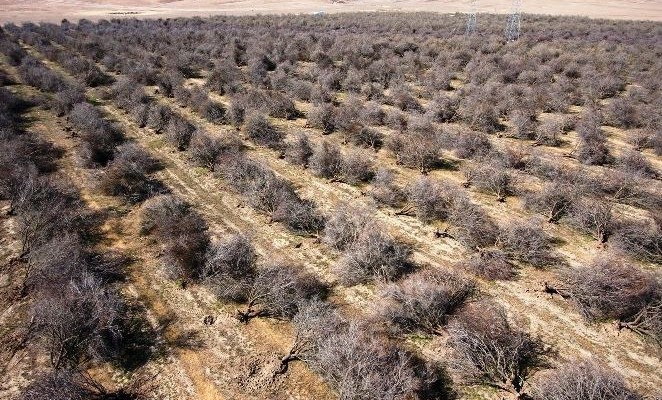Mandatory Water Restrictions
On April 1, Gov. Jerry Brown of California announced the first ever statewide mandatory water reductions. "Today we are standing on dry grass where there should be five feet of snow," Brown said after visiting a manual snow survey in the Sierra Nevada. "This historic drought demands unprecedented action."
The new water restrictions require the state’s 400 local water supply agencies to reduce water usage by 25% overall. While a few smaller farms may be directly affected, the vast majority of farms that obtain their water from sources outside local water agencies will not fall under these new restrictions. Instead, they will be required to make detailed reports on their water usage to state regulators.
 Dead trees await collection in California's San Joaquin Valley, victims of the record-breaking drought. (photo credit: deltacouncil.ca.gov)
Dead trees await collection in California's San Joaquin Valley, victims of the record-breaking drought. (photo credit: deltacouncil.ca.gov)
Zero Water for Agriculture
The news for larger farms remains roughly the same as last year: zero water available. For the second year in a row, many won't receive any water from the Central Valley Project, which allocates water from the state's reservoirs. Farmers continue to respond to these shortages by fallowing vast tracts of land, by purchasing water allotments from their neighbors, by improving their irrigation techniques and by drilling new, deeper wells. According to one UC Davis study last year, California's farmers have been replacing about three-fourths of lost rainfall with water pumped from these wells. Unfortunately, underground aquifers are not simply refilled. Not only are farmers losing a crucial buffer against future droughts, but in some areas in the Central Valley the land itself is actually sinking a foot per year due to aquifer depletion.
In contrast, surface water lagoons and reservoirs provide both water supply and flood management benefits by capturing water whenever it is available and storing it for use when needed. In October last year, one California farmer constructed a
40 acre irrigation reservoir as part of a strategy to save his trees during the prolonged drought. The reservoir, equipped with a unique RPE liner that resists UV degradation and prevents water loss through seepage, allowed him to capture and store water during the brief stormy periods last winter. Prior to construction of the new reservoir, he pumped over 500 acre feet of water into an old reservoir which leaked faster than he could fill it. This year, the new reservoir is full to overflowing with only 385 acre feet. This represents a significant savings of available water plus substantial electricity savings from pumping water.
 A 40 acre irrigation pond lined with BTL's RPEL-30 allows this farmer to store water at a substantially lower cost. (photo credit: BTL Liners)
A 40 acre irrigation pond lined with BTL's RPEL-30 allows this farmer to store water at a substantially lower cost. (photo credit: BTL Liners)
Investing in Surface Water Storage
"BTL is conducting a comprehensive cost analysis to determine when this investment will pay for itself in its entirety. Preliminary indications show a significant cost-savings that will more than justify the client’s investment,” reported Michael Baron, President of BTL Liners. Those farmers who make wise investments in water management infrastructure are positioning themselves not only to survive the current drought with the least damage, but to improve their resilience for future periods of drought or even flooding. California’s agricultural industry should not ask “how much can we harvest per acre?” The question should be, “how much can we harvest with an acre-foot of water?”
“We are in an unprecedented, very serious situation,” Governor Brown warned in January, “At some point, we have to learn to live with nature, we have to get on nature’s side and not abuse the resources that we have.”
If you are a land owner or manager interested in learning more about the construction of irrigation reservoirs and farm ponds using impermeable reinforced polyethylene liners, please visit us online at http://www.btlliners.com or contact our project experts at 541-447-0712.
 Dead trees await collection in California's San Joaquin Valley, victims of the record-breaking drought. (photo credit: deltacouncil.ca.gov)
Dead trees await collection in California's San Joaquin Valley, victims of the record-breaking drought. (photo credit: deltacouncil.ca.gov)
 A 40 acre irrigation pond lined with BTL's RPEL-30 allows this farmer to store water at a substantially lower cost. (photo credit: BTL Liners)
A 40 acre irrigation pond lined with BTL's RPEL-30 allows this farmer to store water at a substantially lower cost. (photo credit: BTL Liners)




